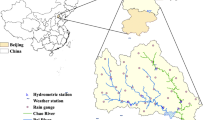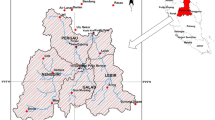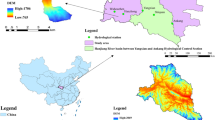Abstract
Non-point source pollution (NPSP) has become a critical pollution source after many improvements in point source pollution treatment have been made, particularly in China, due to intensive agricultural activities. Moreover, the impact of NPSP on surface water quality is significantly affected by extreme events, such as flooding. In this study, the soil and water assessment tool model was used to characterize the behaviours of NPSPs and to evaluate the effect of filter strips during flooding periods. The results showed that a flooding event in 2002 caused by a long duration of rainfall (event_1) contributed approximately 40 % of the annual sediment and organic N yield and 18.4 % of nitrate N yield. In 2007, more than 50 % of the annual sediment and organic N and 20 % of nitrate N export were caused by a flooding event due to heavy rainfall (event_2). The simulation results highlighted the severe threat of flooding events on aquatic environments. Furthermore, filter strips of different widths were simulated in these flooding scenarios to test their mitigation effects on the deterioration of surface water quality during these two events, and the 10-m filter strip did decrease more than 30–40 % of the loads of all NPSPs. Our study stresses that more attention should be paid to assessing the impact of flooding events on water quality management measures and pollution loads, as well as the effect of management practices on both aquatic and terrestrial ecosystems to develop sustainable water and soil resources.





Similar content being viewed by others
References
Behera S, Panda RK (2006) Evaluation of management alternatives for an agricultural watershed in a sub-humid subtropical region using a physical process based model. Agric Ecosyst Environ 113:62–72
Bernal S, Butturini A, Sabater F (2005) Seasonal variations of dissolved nitrogen and DOC: DON ratios in an intermittent Mediterranean stream. Biogeochemistry 75:351–372
Betrie G, Mohamed Y, Griensven AV, Srinivasan R (2011) Sediment management modelling in the Blue Nile Basin using SWAT model. Hydrol Earth Syst Sci 15:807–818
Buda AR, DeWalle DR (2009) Dynamics of stream nitrate sources and flow pathways during stormflows on urban, forest and agricultural watersheds in central Pennsylvania, USA. Hydrol Process 23:3292–3305
Chen Y, Shuai J, Zhang Z, Shi P, Tao F (2014) Simulating the impact of watershed management for surface water quality protection: a case study on reducing inorganic nitrogen load at a watershed scale. Ecol Eng 62:61–70
Cherifi O, Loudiki M (1999) Flood transport of dissolved and suspended matter in the El Abid River basin (Morocco). Hydrobiologia 410:287–294
China Environmental Protection Bureau, 1991–2008, Report on National Environmental Quality of China, Chinese Statistical Press
Chu TW, Shirmohammadi A, Montas H, Sadeghi A (2004) Evaluation of the SWAT modelʼs sediment and nutrient components in the Piedmont physiographic region of Maryland. Trans ASAE 47(5):1523–1538
Coppus R, Imeson A (2002) Extreme events controlling erosion and sediment transport in a semi-arid sub-Andean valley. Earth Surf Proc Land 27:1365–1375
Dai S, Lu X (2010) Sediment deposition and erosion during the extreme flood events in the middle and lower reaches of the Yangtze River. Quat Int 226:4–11
Glavan M, White S, Holman IP (2011) Evaluation of river water quality simulations at a daily time step—experience with SWAT in the Axe catchment, UK. CLEAN Soil Air Water 39(1):43–54
Krause P, Boyle D, Bäse F (2005) Comparison of different efficiency criteria for hydrological model assessment. Adv Geosci 5:89–97
Lam Q, Schmalz B, Fohrer N (2010) Modelling point and diffuse source pollution of nitrate in a rural lowland catchment using the SWAT model. Agric Water Manag 97:317–325
Lee M, Park G, Park M, Park J, Lee J, Kim S (2010) Evaluation of non-point source pollution reduction by applying best management practices using a SWAT model and QuickBird high resolution satellite imagery. J Environ Sci 22:826–833
Leu C, Singer H, Stamm C, Müller SR, Schwarzenbach RP (2004) Variability of herbicide losses from 13 fields to surface water within a small catchment after a controlled herbicide application. Environ Sci Technol 38:3835–3841
Li AX (2003) The situation and the development strategies of organic fertilizer utilization in Hunan Province (in Chinese). Hunan Agric Sci 4(8–9):10
Li S, Gu S, Tan X, Zhang Q (2009) Water quality in the upper Han River basin, China: the impacts of land use/land cover in riparian buffer zone. J Hazard Mater 165:317–324
Munodawafa A (2007) Assessing nutrient losses with soil erosion under different tillage systems and their implications on water quality. Phys Chem Earth Parts A/B/C 32(15):1135–1140
Nakashima S, Yamada Y (2005) Temporal—spatial distributions of high nitrogen concentrations in headwater areas of regions with low precipitation. Limnology 6(1):53–60
Niraula R, Kalin L, Wang R, Srivastava P (2012) Determining nutrient and sediment critical source areas with SWAT: effect of lumped calibration. Trans ASABE 55(1):137–147
Oeurng C, Sauvage S, Sánchez-Pérez JM (2010) Temporal variability of nitrate transport through hydrological response during flood events within a large agricultural catchment in south-west France. Sci Total Environ 409:140–149
Oeurng C, Sauvage S, Sánchez-Pérez JM (2011) Assessment of hydrology, sediment and particulate organic carbon yield in a large agricultural catchment using the SWAT model. J Hydrol 401:145–153
Panagopoulos Y, Makropoulos C, Baltas E, Mimikou M (2011) SWAT parameterization for the identification of critical diffuse pollution source areas under data limitations. Ecol Model 222(19):3500–3512
Parajuli P, Mankin K, Barnes P (2008) Applicability of targeting vegetative filter strips to abate fecal bacteria and sediment yield using SWAT. Agric Water Manag 95:1189–1200
Pisinaras V, Petalas C, Gikas GD, Gemitzi A, Tsihrintzis VA (2010) Hydrological and water quality modeling in a medium-sized basin using the Soil and Water Assessment Tool (SWAT). Desalination 250:274–286
Prasuhn V, Sieber U (2005) Changes in diffuse phosphorus and nitrogen inputs into surface waters in the Rhine watershed in Switzerland. Aquat Sci 67:363–371
Ribarova I, Ninov P, Cooper D (2008) Modeling nutrient pollution during a first flood event using HSPF software: Iskar River case study. Bulgaria. Ecol Model 211:241–246
Rozemeijer J, Broers H (2007) The groundwater contribution to surface water contamination in a region with intensive agricultural land use (Noord-Brabant, The Netherlands). Environ Pollut 148:695–706
Rusjan S, Brilly M, Mikoš M (2008) Flushing of nitrate from a forested watershed: an insight into hydrological nitrate mobilization mechanisms through seasonal high-frequency stream nitrate dynamics. J Hydrol 354:187–202
Sahu M, Gu RR (2009) Modeling the effects of riparian buffer zone and contour strips on stream water quality. Ecol Eng 35(8):1167–1177
Shen Z, Liao Q, Hong Q, Gong Y (2012) An overview of research on agricultural non-point source pollution modelling in China. Sep Purif Technol 84:104–111
Shrestha S, Kazama F, Newham LT (2008) A framework for estimating pollutant export coefficients from long-term in-stream water quality monitoring data. Environ Model Softw 23:182–194
Verstraeten WW, Veroustraete F, Feyen J (2006) On temperature and water limitation of net ecosystem productivity: implementation in the C-Fix model. Ecol Model 199:4–22
Volk M, Liersch S, Schmidt G (2009) Towards the implementation of the European Water Framework Directive? Lessons learned from water quality simulations in an agricultural watershed. Land Use Policy 26:580–588
Wang X, Melesse AM (2006) Effects of STATSGO and SSURGO as inputs on SWAT modelʼs snowmelt simulation. Jawra J Am Water Resour Assoc 42:1217–1236
Weiler M, McDonnell JJ (2006) Testing nutrient flushing hypotheses at the hillslope scale: a virtual experiment approach. J Hydrol 319:339–356
White MJ, Arnold JG (2009) Development of a simplistic vegetative filter strip model for sediment and nutrient retention at the field scale. Hydrol Process 23:1602–1616
Yi C, Cheng SG, Hu GP, Yang XX (2007) The situation and the control measures for the breeding pollution in Hengyang (in Chinese). Anim Husb Feed Sci 04:71–74
Zhang Z, Fukushima T, Onda Y, Gomi T, Fukuyama T, Sidle R, Ki Kosugi, Matsushige K (2007) Nutrient runoff from forested watersheds in central Japan during typhoon storms: implications for understanding runoff mechanisms during storm events. Hydrol Process 21:1167–1178
Zhang Z, Fukushima T, Onda Y, Mizugaki S, Gomi T, Ki Kosugi, Hiramatsu S, Kitahara H, Kuraji K, Terajima T (2008) Characterisation of diffuse pollutions from forested watersheds in Japan during storm events—its association with rainfall and watershed features. Sci Total Environ 390:215–226
Zhang Y, Guo F, Meng W, Wang XQ (2009) Water quality assessment and source identification of Daliao River basin using multivariate statistical methods. Environ Monit Assess 152(1–4):105–121
Zhang QL, Chen YX, Jilani G, Shamsi IH, Yu QG (2010a) Model AVSWAT apropos of simulating non-point source pollution in Taihu Lake basin. J Hazard Mater 174:824–830
Zhang Z, Tao F, Shi P, Xu W, Sun Y, Fukushima T, Onda Y (2010b) Characterizing the flush of stream chemical runoff from forested watersheds. Hydrol Process 24:2960–2970
Zhang Z, Chen Y, Wang P, Shuai J, Tao F, and Shi P (2013) River discharge, land use change, and surface water quality in the Xiangjiang River, China. Hydrol Process doi:10.1002/hyp9938
Acknowledgments
This study was funded by Creative Research Groups of National Natural Science Foundation of China (No. 41321001), the National Basic Research Program of China (2012CB955404), and the Program of Introducing Talents of Discipline to Universities (B08008).
Author information
Authors and Affiliations
Corresponding author
Additional information
Handling Editor: Richard Sheibley.
Rights and permissions
About this article
Cite this article
Chen, Y., Song, X., Zhang, Z. et al. Simulating the impact of flooding events on non-point source pollution and the effects of filter strips in an intensive agricultural watershed in China. Limnology 16, 91–101 (2015). https://doi.org/10.1007/s10201-014-0443-2
Received:
Accepted:
Published:
Issue Date:
DOI: https://doi.org/10.1007/s10201-014-0443-2




